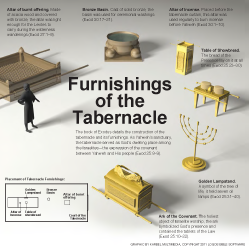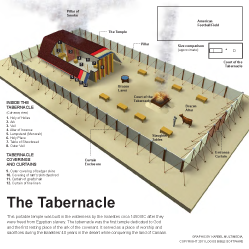The Future of Bible Study Is Here.
 Loading…
Loading…
You have not started any reading plans.
- More »
Sign in or register for a free account to set your preferred Bible and rate books.
8:1–4 Numbers 8:1–4 contain instructions for mounting the lamps of the great golden lampstand
|
8:2 Aaron Only the priests conducted activity inside the holy place of the tent of meeting once the tabernacle had been constructed (see Num 3:5–10).
of the tent of meeting once the tabernacle had been constructed (see Num 3:5–10).
 Tabernacle AYBD
Tabernacle AYBD
 Tabernacle DOT: P
Tabernacle DOT: P
seven lamps See note on Exod 25:37.
the lampstand Refers to the golden lampstand (menorah) in the holy place. See note on Exod 25:31.
8:4 the pattern that Yahweh showed Moses When Yahweh communicated the instructions for the tabernacle and its furnishings to Moses, He showed Moses a pattern or blueprint. See Exod 25:9 and note.
8:5–22 The tribe of the Levites was dedicated to God in place of the firstborn of all Israel (Num 3:11–13, 40–51). Numbers 3:14–39 describes their duties in service to God: guarding the sanctuary from ritual defilement by anyone not permitted in sacred space (3:14–39) and transporting the tabernacle (4:1–33). Like the priests (Exod 29; Lev 8), the Levites had to be ritually purified before beginning service. Levites between the ages of 25 and 50 were eligible for service and had to be purified (Num 8:24–25). Unlike the priests, the Levites were not consecrated with oil (compare Exod 29:7, 21); such an anointing was reserved for the priests, permitting them access to the sacred objects within the tent of meeting. The Levites were forbidden to enter the tent or offer sacrifice at the bronze altar (Num 18:3–4), and the priests had to cover the sacred furnishings before the Levites could transport them safely (1:53; 4:5–12).
|
8:6 purify Although cleansing or purification often involved washing or water, the underlying rationale had little to do with hygiene; rather, washing was an outward gesture that symbolized the purification of the person’s being.
8:7 waters of purification The procedures described here presume the instructions related to purification from ch. 19.
they will shave their whole body The opposite of the regulations for a Nazirite (compare 6:1–8); the Levites were required to eliminate all of their body hair.
8:8 a young bull The bull was the most highly prized and costly domesticated animal, therefore it was required for the purification of the Levites, who held special status.
grain offering of The Hebrew name for the grain offering is minchah (see Lev 2:1–16 and note). While minchah as a basic sense of “gift,” it is a technical term for the grain offering in priestly contexts.
 Qorban NIDOTTE
Qorban NIDOTTE
 Minchah NIDOTTE
Minchah NIDOTTE
 Types of Offerings in the Old Testament Table
Types of Offerings in the Old Testament Table
a sin offering When a person unknowingly sinned, their offense affected the sanctity of the sanctuary. The chatta'th (or purification offering) cleansed the contamination. See note on Lev 4:1–5:13.
8:9 the tent of assembly The internal tent structure of the tabernacle proper—the most holy place where the ark of the covenant was kept (Exod 25:22; Num 7:89). See note on 1:1.
proper—the most holy place where the ark of the covenant was kept (Exod 25:22; Num 7:89). See note on 1:1.
 Tabernacle AYBD
Tabernacle AYBD
 Tabernacle DOT: P
Tabernacle DOT: P
8:10 will lay their hands on the Levites The elders of Israel (as opposed to every person in the Israelite camp) conducted this rite. This gesture symbolically showed that the Levites were Israel’s “sacrifice” (i.e., given back to God in service and in lieu of the firstborn; compare 3:11–13, 40–51; 8:11).
8:11 will offer the Levites as a wave offering A wave offering (tenuphah in Hebrew; see note on Lev 7:30) involved elevating the thing offered to God. The thing offered becomes the property of God. The use of tenuphah is peculiar in this passage because a group of people are being offered in this way. Normally a wave offering consists of meat (e.g., Exod 29:24–27; Lev 7:30) or grain (e.g., Lev 23:15; Num 5:25) that is literally lifted up by the priest. This signals that the Levites are consecrated before Yahweh—their lives are devoted to his service. Compare note on v. 14.
(tenuphah in Hebrew; see note on Lev 7:30) involved elevating the thing offered to God. The thing offered becomes the property of God. The use of tenuphah is peculiar in this passage because a group of people are being offered in this way. Normally a wave offering consists of meat (e.g., Exod 29:24–27; Lev 7:30) or grain (e.g., Lev 23:15; Num 5:25) that is literally lifted up by the priest. This signals that the Levites are consecrated before Yahweh—their lives are devoted to his service. Compare note on v. 14.
8:12 make atonement Refers to the purging of impurity. See note on Lev 4:20.
See note on Lev 4:20.
8:14 the Levites will be for me The Levites are set apart for the service of Yahweh in place of the firstborn of all Israel (Num 3:11–13; see note on 3:1–51).
8:16 firstborn The Levites take the place of all the firstborn of Israel as those dedicated to the service of Yahweh (3:11–13, 40–51). Compare Exod 13:1–2; 22:29–30; 34:19–20.
8:17 I consecrated them to me See note on Num 3:12.
I consecrated The Hebrew word used here, qadash, means “to be holy” or “make holy.” The concept of holiness fundamentally indicates separation: A person
fundamentally indicates separation: A person or item is set apart for sacred use or duty, as opposed to common, ordinary tasks or purposes.
or item is set apart for sacred use or duty, as opposed to common, ordinary tasks or purposes.
 Priests, Priesthood DOT: P
Priests, Priesthood DOT: P
8:19 a plague will not be When the Israelites did not follow Yahweh’s instruction, they risked an outbreak of plague or divine wrath. See note on 1:53.
the sanctuary Refers to the tabernacle’s precincts and tent structure.
8:20 the entire community of The people were united in their obedience to the command of Yahweh with respect to the Levites.
8:23–26 This brief section contains instructions about what to do when a Levite reaches 50 years old, the age of retirement. |
8:24 those twenty-five years old and above See note on 4:3.
Levitical service began at age 30 according to 4:3. In the postexilic period, the Levites began serving at age 20 probably due to the small number of Levites available for service after the Babylonian exile (1 Chr 23:24, 27; 2 Chr 31:17; Ezra 3:8).
 Age Limits for Levitical Duties Numbers (JPS)
Age Limits for Levitical Duties Numbers (JPS)
8:26 concerning the Levities and their responsibilities These duties are spoken of in more detail in Lev 3–4.

|
About Faithlife Study BibleFaithlife Study Bible (FSB) is your guide to the ancient world of the Old and New Testaments, with study notes and articles that draw from a wide range of academic research. FSB helps you learn how to think about interpretation methods and issues so that you can gain a deeper understanding of the text. |
| Copyright |
Copyright 2012 Logos Bible Software. |
| Support Info | fsb |

